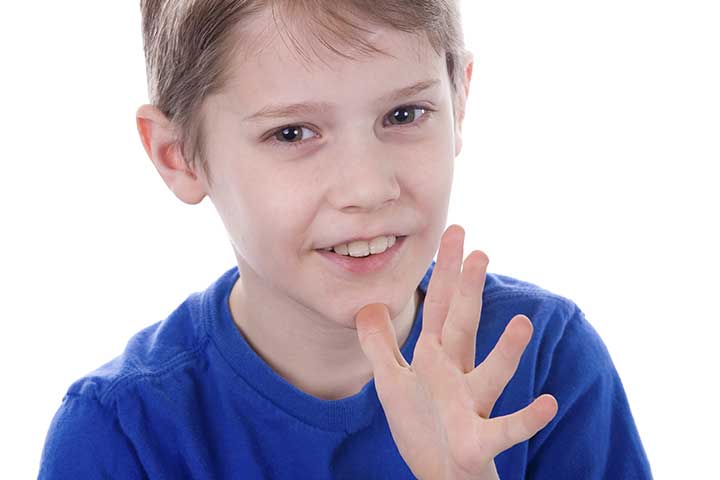
Image: Shutterstock
Embarking on the journey of parenthood is a beautiful experience filled with countless cherished moments and significant milestones. Among these remarkable milestones, one of the most exhilarating ones is witnessing your little one begin to communicate with you. While it may take time for your baby to develop spoken language skills, introducing them to basic baby sign language words can offer a means of expression and enhance their understanding.
Baby sign language stands as a straightforward and highly effective tool for bridging the communication gap between you and your baby. Research indicates that even infants as young as six months old can grasp and employ sign language to convey their needs and desires (1). This leads to a reduction in frustration for both parents and their precious bundles of joy.
In this article, we’ll embark on a journey to explore some essential baby sign language words that you can readily introduce to your baby. These signs encompass some of the most common needs and desires your baby is likely to experience, ultimately fostering smoother and more enjoyable daily interactions for both of you. Read on to know more!
1. Mommy
Image: Shutterstock
How To Sign It
Extend the fingers of one hand, then gently tap the side of your chin using the thumb of that hand several times.
Teaching your baby the sign for “Mommy” is a heartwarming way to strengthen your bond. When your little one can express their need for you, it can make them feel more secure and connected.
2. Daddy
How To Sign It
Extend the fingers of one hand, and then lightly tap the side of your forehead with the thumb of that hand several times.
Much like “Mommy,” teaching your baby the sign for “Daddy” helps them communicate their desire to be with their other parent. It’s a sweet way to acknowledge their attachment to both of you.
3. Again
How To Sign It
With one hand open and the other’s fingers curved, start with your hands apart, then bring your fingertips across your body, tapping the open palm, and repeat.
The word “Again” is a favorite among little ones who love repetition. When they sign for “Again,” it’s a clear indication that they want you to repeat an activity or action.
4. Eat
Image: Shutterstock
How To Sign It
Gather your fingertips together to create a point, and position that hand in front of your lips, which should be pursed. Move your hand away from your mouth and then back to it.
“Eat” is one of the most practical baby sign language words you can teach your baby. It allows them to let you know when they’re hungry and ready for a meal.
5. More
How To Sign It
Pinch the tips of your fingers on both hands to create two points. Make these points touch, then separate them, and repeat this motion a few times.
The sign for “More” is invaluable because it can be used in various situations. Whether your baby wants more food, more playtime, or more of anything else, this sign helps them convey that desire.
6. Sleep
How To Sign It
Image: Shutterstock
Position one hand in front of your face, with the palm facing toward you. Form a fist and lower it to your chin while closing your eyes. Slowly move the closed fist downward while keeping your eyes closed.
Teaching your baby the sign for “Sleep” is particularly helpful during naptime and bedtime routines. It lets them express when they’re tired and ready for some rest.
7. Cold
How To Sign It
Raise your shoulders slightly and clasp both hands in front of your body near your shoulders. You can add a slight shivering motion for added effect.
“Cold” is an essential sign, especially during colder months. It allows your baby to communicate when they’re feeling chilly, helping you ensure they stay comfortable and warm.
8. Milk
How To Sign It
Image: Shutterstock
Form a fist with one hand and position it in front of your chest, mimicking the gesture of holding a bottle.
“More” isn’t the only way for your baby to ask for something to eat. The sign for “Milk” is especially handy when they’re craving their favorite drink.
9. Bath
How To Sign It
Close your hands and hold them in front of your chest. Proceed to move them up and down in alternating directions, simulating the action of scrubbing your body.
The sign for “Bath” helps your baby express their readiness for a refreshing bath. It’s a useful sign to incorporate into your daily routine.
10. Bye-Bye
Image: Shutterstock
How To Sign It
Bend your fingers and gently wave your open palm from side to side near your shoulder.
“Bye-Bye” is a universally recognized sign, making it easy for your baby to say goodbye to friends and family when it’s time to leave.
Baby sign language is a wonderful tool that fosters early communication and deepens the connection between you and your baby. It allows them to express their needs and desires, reducing frustration for both of you. So, start with these basic signs, and enjoy the journey of watching your baby communicate with you in their unique way.

















